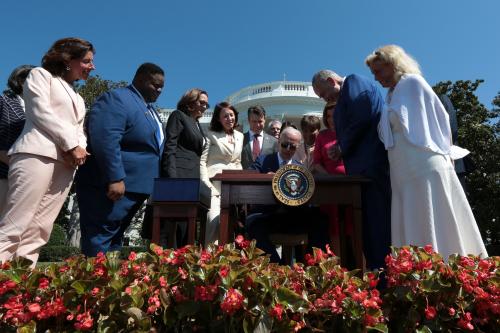In case you missed it, you can watch here an event with the Brookings Metro team, outside experts, and Sens. Maria Cantwell and Tom Carper on the future of American infrastructure, held on April 15, 2021.
Three years after the Trump administration’s February 2018 infrastructure proposal failed to get off the ground, the Biden’s administration infrastructure package—the American Jobs Plan—is seeing a far different response. Sure, there are debates about how much to spend, where tax revenue should come from, and even what the word “infrastructure” means. But across it all, there is a prevailing tone that this proposal could lead to genuine policy change.
What makes President Joe Biden’s plan different? The scope and the spending are certainly bigger, far exceeding the Trump plan or anything the Obama, George W. Bush, or Clinton administrations ever formally proposed. But perhaps something far more fundamental has captured the country’s collective imagination.
The Biden proposal is a philosophical statement of purpose. It visualizes a more inclusive, sustainable, and competitive country—and then offers ideas on how to build it. After four years of cynicism and abdication, the American Jobs Plan is a beacon of candor and optimism.
First, let’s explain the candor. Contrary to popular opinion—and as The Washington Post’s Charles Lane and our Rand Corporation colleagues lay out well—American infrastructure is far from crumbling. Instead, our problems relate more to sustainability and inequity.
These challenges are all around us. Natural disasters now cost the country an average of $81 billion per year in damages—up 355% since the 1980s. Urban heat islands and decaying water pipes continue to impact our most disadvantaged communities. Over 70% of farmers struggle to compete due to a lack of broadband connectivity. This is just a sampling of the modern needs that infrastructure should address—and that the Biden plan prioritizes.
The proposal is also candid about the vast value chain that it takes to operate infrastructure systems. Our politics often portray infrastructure as nothing more than construction projects and the workers who build them. That gives infrastructure short shrift. Infrastructure starts with extensive research and development, from making water pipes less likely to burst to broadband that runs faster. Building projects also create demand for a substantial set of manufactured products, including complex software, construction equipment, and advanced materials. And construction is just a slice of the infrastructure labor force; the vast majority of the country’s 17 million infrastructure workers focus on design, operations, and maintenance.
The American Jobs Plan aims to strengthen this value chain, from supporting workforce development programs to growing R&D spending to building our innovation capacity.
Which brings us to the plan’s optimism. Biden’s plan is an enormous bet on America—a bet that trillions of dollars of targeted investment can improve people’s lives, make our industries more globally competitive, and repair our fragile natural world. It’s also a major bet on the power of federal investment. Rather than asking states and cities to do more, as the Trump administration’s plan sought, the proposal recognizes the economic moment and essentially says that it’s time for the federal government to lead.
Put it all together and the Biden proposal offers the most powerful ingredient when it comes to infrastructure reform: It sells a vision. The plan unapologetically calls out our next destination, whether that’s safer streets or cleaner power. It offers sweeping investments to make such a vision real, from replacing aging pipes to delivering rural broadband. And it brings people—especially our workforce—along for the ride.
The plan’s specifics represent just the start of a long debate, and Congress will have the final say. Many more reform ideas will surface as that debate takes shape, including a major vision Brookings Metro will release next week.
But for now, Biden has used the stump the way a forward-looking president should. The administration has delivered a vision to the American people—a promise of a new kind of country. And the country itself is responding, with polling that shows bipartisan support for the plan’s ideas.
America was built for these kinds of grand visions. It is starting to feel like another one may soon come to life.






Commentary
Biden’s infrastructure plan replaces federal cynicism with a sweeping vision
April 9, 2021